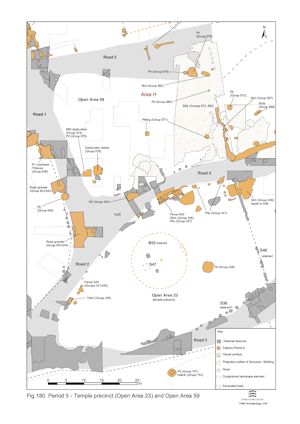

The Structure 44 division seems to be short-lived and is probably removed late in Period 5. Technically, OAs 46 and 59 could be assumed to revert to a single entity (Figure 177, Figure 180, Figure 181). The few pits, structures and accumulating deposits of probable mid-4th century date tend to indicate decline and abandonment, rather than change and development following the demise of Structure 44.
The fills (Group 653) of ditch 25260 (Group 584) that is imposed along the edge of Road/track 4 should be noted. Although treated as Period 6 during preliminary analysis, both these ditch fills and the infill of the robbing of Structure 44 (Group 567) are sealed by a sequence of Late Roman occupation silts (Groups 573, 583). The pottery of fill 16333 (in ditch 25260 segment 16338) is very similar in type and condition to that in 16196 (Group 567 Structure 44), the robbing of the wall line across the western part of Open Area 46, even to the extent of some sherd linkages - both assemblages are very abraded and may have been deposited (or redeposited) as late as some time in the 5th century.
Extensive, dark, sandy silts accumulate over much of the western part of Open Area 46 in the later stages of Period 5 (6020, 6025, 6043, 6050, 6118, 6172, 6174, 6226, 6227, 16130, 16166, 16187, 16236 Group 573, 6153 Group 583). The layers are often homogeneous and some of the contexts are in effect arbitrary spits (e.g. 16130, 16166) removed in an effort to define distinct features and deposits more clearly. This sequence overlies other silts (Groups 570, 581) that are in all respects similar but have been subdivided into separate groups because of intervening, excavated features (pit Group 570 and slot Group 582). However, some contexts within these groups are not silts but instead define patchy gravel resurfacings interleaving with them.
The majority of these layers include large quantities of finds of a wide range of types, but chiefly, as usual, pottery and ceramic building material. It seems clear enough that most of these are real archaeological layers, although they probably also include undistinguished features within them. It is interesting that nearly all those with particularly noted residual contents have specifically mid-3rd century residual pottery. This suggests that there is not much activity in the later 3rd century in this area. A scan of the pottery dates from this part of the site (Excavation Area H) as a whole suggests that this may well be the case; only thirteen assemblages of late 3rd or late 3rd-early 4th century are listed. Even if we allow that some of this pottery may be less distinctively datable, this does appear to suggest a real gap, or at least a drop, in activity during this period. Equally, there can be no doubt there is a strong period of activity in the 4th century.
These silty layers extend over the gravel surfaces within Open Area 46 and encroach upon Road 4. However, they do not represent abandonment, as continued activity clearly post-dates them; for example layer 6025 (which is rich in metal finds, including coins) is overlain by patchy gravel surface 6020 (Group 573) and may even constitute a deliberate make-up for this surface.
A possible hearth (16181/16198 Group 569) was regarded as Period 6 during preliminary analysis, but appears to be within or sealed by this sequence of silts. 16181 is a c. 0.7m square pad of tile fragments, set one course deep on clay base 16198. There is some evidence of burning, especially of the clay rather than the tile, but the presence of a limestone fragment on top of the tile may suggest that this feature is a post-pad and relates in some way to fence/wall Structure 44 (which it overlies). Alternatively it may be little more than bonded rubble thrown into a cut related to the robbing the Structure 44 feature.
In the western part of OA46, deposit 6269 (Group 581) represents an apparently arbitrary spit through silty deposits that seal pit 6641 containing the pewter hoard (Group 579). These silts are in turn cut by a small slot (6252 Group 582). Like the other examples discussed previously (Group 568), little interpretation can be offered for this isolated feature, other than to observe that further undefined structural activity may be present in Open Area 46 during Period 5.
Two fragments of very shallow and narrow linear features, (7437, 7439 Group 876), apparently structural slots, indicate encroachment onto Road 5. They might represent a building, the foundations of which rested upon, as much as penetrated, the latest (Period 4) Road 5 surface. Although recorded as a vaguely D-shaped impression on the road surface, as cut features the slots are negligible. No artefactual material was recovered and their assignment to this period is therefore tentative and they could be later. An extremely shallow pit 7435 (Group 882) is immediately adjacent and possibly relates to these slots.
See Northern zone (east of Road 1) for further consideration of these features in relation to structural remains within that part of the Northern Zone east of Road 1.
Internet Archaeology is an open access journal based in the Department of Archaeology, University of York. Except where otherwise noted, content from this work may be used under the terms of the Creative Commons Attribution 3.0 (CC BY) Unported licence, which permits unrestricted use, distribution, and reproduction in any medium, provided that attribution to the author(s), the title of the work, the Internet Archaeology journal and the relevant URL/DOI are given.
Terms and Conditions | Legal Statements | Privacy Policy | Cookies Policy | Citing Internet Archaeology
Internet Archaeology content is preserved for the long term with the Archaeology Data Service. Help sustain and support open access publication by donating to our Open Access Archaeology Fund.